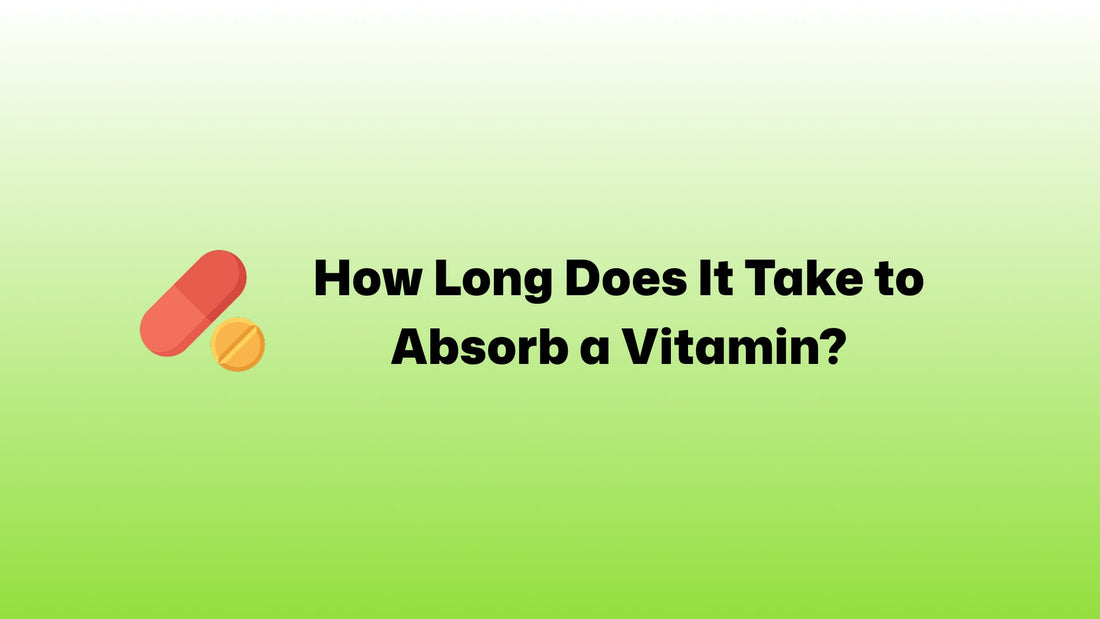
How Long Does It Take to Absorb a Vitamin?
Share
Vitamins are essential nutrients, but many people are unsure how long they take to be absorbed after consumption. This depends on several factors, including the type of vitamin, the form it's taken in, and whether it's consumed with food.
In this article, we explain the typical absorption times for different types of vitamins and how various factors affect the process. We’ll also clarify how fast you might feel the effects of a vitamin and how your body uses it once absorbed.
Understanding how vitamins work in the body can help with better supplement use. Whether taken for health maintenance or to correct a deficiency, knowing when and how vitamins are absorbed is key to getting the most benefit.
Absorption Time of Water-Soluble Vitamins
Water-soluble vitamins are absorbed faster than fat-soluble ones. They do not need fat or bile for absorption and dissolve easily in the digestive system. Most of them start absorbing within 1 to 4 hours after they are taken.
These vitamins move into the bloodstream through the walls of the small intestine. Absorption speed depends on the type of vitamin and how much is taken. In small to moderate doses, the body absorbs them efficiently. When the dose is too high, the body takes in less and removes the extra through urine.
The following water-soluble vitamins are among the fastest to absorb:
- Vitamin C: Starts absorbing within 30 to 60 minutes. Peak absorption happens when taken in doses under 200 mg.
- Vitamin B1 (Thiamine): Absorbs quickly through active transport in the small intestine.
- Vitamin B2 (Riboflavin): Also uses active transport and absorbs within a few hours.
- Vitamin B3 (Niacin): Absorbs through passive diffusion and enters the bloodstream in less than 2 hours.
Vitamin B12 behaves differently from other B vitamins. It requires a protein called intrinsic factor for proper absorption and takes longer. It may take up to 6 hours or more to be fully absorbed.
Because water-soluble vitamins are not stored in large amounts, they should be taken regularly. Smaller, frequent doses are more effective than large single doses. This helps the body absorb what it needs without wasting the rest.
Absorption Time of Fat-Soluble Vitamins
Fat-soluble vitamins are absorbed more slowly than water-soluble ones. They need both dietary fat and bile acids to move through the digestive system. Without enough fat in the meal, absorption becomes limited.
These vitamins include A, D, E, and K. They are absorbed in the small intestine and then enter the lymphatic system before reaching the blood. Most of them begin to absorb within 2 to 6 hours after being consumed, depending on the meal content and digestion speed.
Among fat-soluble vitamins, the fastest to absorb under proper conditions are:
- Vitamin D3: Absorbs within 2 to 4 hours if taken with fat. Absorption improves significantly when consumed with a high-fat meal.
- Vitamin K2: Starts absorbing within 2 to 5 hours. Its absorption depends heavily on bile and fat intake.
- Vitamin A (as retinol): Absorbs within 3 to 6 hours, especially when taken with foods containing oils or animal fats.
Vitamin E is also fat-soluble, but its absorption is slower and more variable compared to others. It is stored in fat tissues and enters circulation gradually.
The efficiency of fat-soluble vitamin absorption increases when taken with meals that include 10 to 15 grams of healthy fat. Foods like eggs, nuts, seeds, oily fish, olive oil, and full-fat dairy improve absorption.
Unlike water-soluble vitamins, these are stored in liver and fat tissues. Daily intake is not always necessary. However, excessive intake over time can cause toxicity, especially with vitamins A and D.
Differences Between Natural and Synthetic Forms
Natural and synthetic vitamins can differ in how well they are absorbed and used by the body. Some synthetic forms are less bioavailable, while others are equal or even better, depending on how the body processes them.
Vitamin E is one of the best examples. The natural form, labeled as d-alpha-tocopherol, is absorbed and retained more effectively than the synthetic version, dl-alpha-tocopherol. The body prefers the natural form because of its molecular structure.
Folic acid, a synthetic version of vitamin B9, is absorbed well but must be converted in the liver into the active form known as 5-MTHF. Some people with a genetic variant in the MTHFR gene may convert it slowly, which affects its effectiveness.
Vitamin D exists in two main forms: D2 (ergocalciferol) and D3 (cholecalciferol). Both are absorbed in the same way, but D3 raises blood vitamin D levels more effectively and stays in the body longer.
Sublingual and liquid forms of some vitamins may start absorbing faster than tablets.
Role of Food, Digestion, and Enzymes
The way the body digests food strongly affects how vitamins are absorbed. Digestive enzymes, stomach acid, and bile production all play key roles in making nutrients available for absorption.
Fat-soluble vitamins depend on the breakdown of fats. If the body has problems producing bile or lipase, absorption of vitamins A, D, E, and K becomes limited. This is common in people with liver or gallbladder conditions.
Protein-bound vitamins, like vitamin B12 found in meat and dairy, need stomach acid and pepsin to be released. Without enough stomach acid, absorption becomes difficult even if intake is high. This is often seen in older adults or those taking acid-reducing medications.
The presence of food improves vitamin absorption in most cases. For example, vitamin D is better absorbed with meals that include fat. One clinical study found that vitamin D3 absorption nearly doubled when taken with a high-fat meal compared to being taken on an empty stomach.
Gut bacteria also support the body's vitamin status. Some strains produce small amounts of B vitamins such as B7 (biotin) and B12. However, this production is not enough to meet daily needs, and dietary intake remains essential.
Absorption Speed of Common Vitamin Supplement Forms
The form of a vitamin supplement can affect how quickly it is absorbed and how well it works. Tablets, capsules, liquids, powders, and chewables each behave differently in the digestive system.
Liquid vitamins usually begin absorption faster than solid forms. They do not need to dissolve first and can pass through the stomach more quickly. Absorption may begin within 15 to 30 minutes for high-quality liquid supplements.
Tablets need to break down in the stomach before absorption begins. If they are poorly made or coated too heavily, they may dissolve too slowly or unevenly. This can delay absorption by an hour or more.
Some supplements have enteric coatings, which protect the vitamin from stomach acid and delay absorption until the tablet reaches the small intestine. This is helpful for sensitive compounds but may add 1 to 2 hours to the absorption process.
Extended-release forms release small amounts of the vitamin over several hours. This slows down absorption on purpose to maintain stable blood levels but may reduce how quickly effects are noticed.
Multivitamins often combine many nutrients. Some vitamins in these products can interfere with each other's absorption. For example, high doses of calcium can reduce magnesium or zinc absorption. Splitting supplements between meals can help reduce these interactions.
How Long It Takes to Feel the Effects of Vitamin Absorption
Most vitamins begin absorption within a few hours, but feeling the effects takes longer. The time between absorption and noticeable results depends on the vitamin type, your nutrient status, and the reason you take the supplement.
Water-soluble vitamins, such as B12 or B6, can sometimes affect energy or mood within days if there was a mild deficiency. Fat-soluble vitamins take longer to build up in the body. Vitamin D, for example, helps regulate calcium and immune function, but its impact may not be felt for several weeks.For some vitamins, the body prioritizes storage over immediate function. For example, vitamin A may be absorbed and stored in the liver without producing quick effects.
Absorption vs. Bioavailability
Absorption and bioavailability are not the same. Absorption means the vitamin enters the bloodstream. Bioavailability means it reaches and is used by the body’s cells in an active form.
A vitamin can be well absorbed but still poorly used. For example, folic acid is absorbed quickly, but it must be converted into an active form in the liver. If this step is inefficient due to genetics or liver issues, bioavailability is low despite good absorption.
Some supplements are formulated to improve bioavailability. These include forms like methylated B vitamins, micellized vitamin D, or liposomal vitamin C. However, even with advanced formulations, bioavailability is still influenced by digestion, genetics, and the presence of other nutrients.
